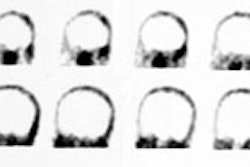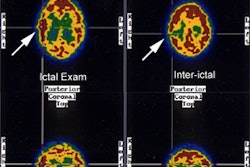Brain SPECT in Psychiatric Disorders:
Tc99m-HMPAO may be more useful than EEG in determining response to therapy in patients with psychiatric disorders.
Schizophrenia:
Schizophrenia is characterized by disordered affect, behavior, and thinking [3]. A finding consistently suggested on both PET FDG and SPECT perfusion imaging in patients with schizophrenia has been that of hypofrontality (i.e., relative decreased frontal perfusion/metabolism). Improved cortical activity in this region is seen following institution of therapy. Please refer to the section on PET imaging in schizophrenia for a more detailed discussion.
Attention Deficit-Hyperactivity Disorder (ADHD):
Xe-133 SPECT imaging has demonstrated hypoperfusion of the caudate and central frontal lobes, with relatively hyperperfused occipital lobes in these children. This pattern is consistent with some neurophysiologic models of the disorder. After treatment with methylphenidate, the rCBF abnormalities tended to reverse.
Bipolar Disorders:
Frontal or global hypometabolism has been described, as well as temporal lobe asymmetries. With depression, symmetric hypofrontality has been described. Findings have generally been inconsistent, most likely due to the heterogeneity of these disorders.
Unipolar Disorders:
Loss of interest or pleasure, feelings of hopelessness, and reduced energy are symptoms of unipolar depression [3]. Patients with depression demonstrate decreases in regional cerebral flow and metabolism typically in the frontal and prefrontal regions, but also in temporal (transverse temporal gyrus), parietal, and limbic-subcortical structures (caudate, amygdala, thalamus, and hypothalamus) [4]. Global hypometabolism and caudate nucleus hypometabolism have also been described. A consistent finding in patients suffering from depression is lateral frontal cortex perfusion defects (left > right) [1]. Cerebral blood flow alterations in depression generally normalize after a response to medical treatment, however, this may not be seen following electroconvulsive therapy (despite a clinical response) [4]. In fact, following ECT response, studies can demonstrate a bilateral decrease in rCBF in the parietotemporal and cerebellar cortices [4].
Autistic Disorder:
In a study of 6 autistic patients, abnormally decreased rCBF was detected within the temporal and parietal lobes [2].
REFERENCES:
(1) J Nucl Med 1992; Holman B, et al. Functional brain SPECT: The emergence of a powerful
clinical method. 33: 1888-1904
(2) J Nucl Med 1995; Mountz J, et al. Functional deficits in autistic disorder: Characterization by technetium-99m-HMPAO and SPECT. 36: 1156-1162
(3) J Nucl Med 2001; Camargo EE. Brain SPECT in Neurology and Psychiatry. 42: 611-623
(4) J Nucl Med 2007; Kohn Y, et al. 99mTc-HMPAO SPECT study of cerebral perfusion after treatment with medication and electroconvulsive therapy in major depression. 48: 1273-1278



